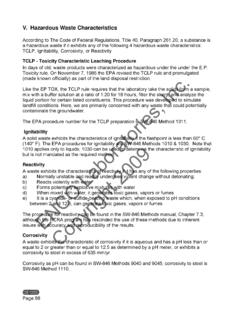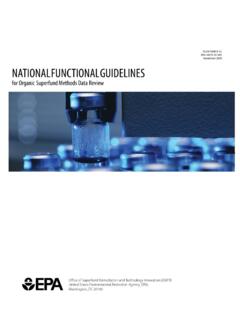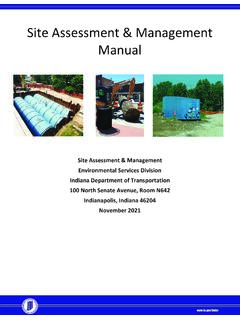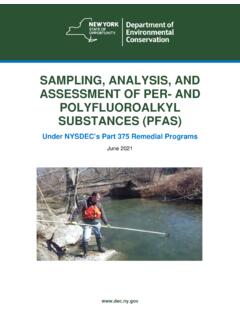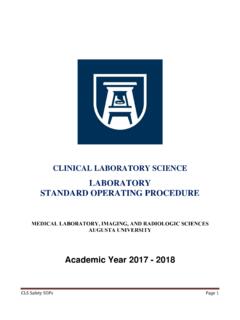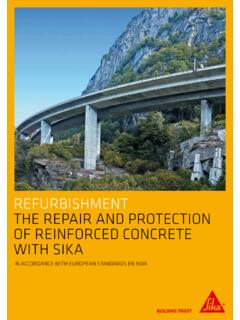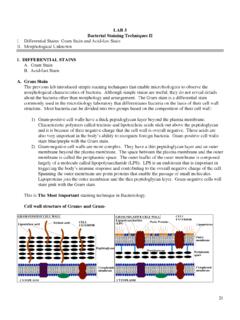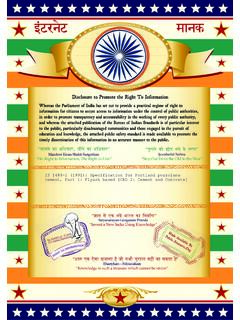Transcription of METHOD 1311 TOXICITY CHARACTERISTIC LEACHING …
1 METHOD 1311. TOXICITY CHARACTERISTIC LEACHING PROCEDURE. SCOPE AND APPLICATION. The TCLP is designed to determine the mobility of both organic and inorganic analytes present in liquid, solid, and multiphasic wastes. If a total analysis of the waste demonstrates that individual analytes are not present in the waste, or that they are present but at such low concentrations that the appropriate regulatory levels could not possibly be exceeded, the TCLP need not be run. If an analysis of any one of the liquid fractions of the TCLP. extract indicates that a regulated compound is present at such high concentra- tions that, even after accounting for dilution from the other fractions of the extract, the concentration would be above the regulatory level for that compound, then the waste is hazardous and it is not necessary to analyze the remaining fractions of the extract.
2 If an analysis of extract obtained using a bottle extractor shows that the concentration of any regulated volatile analyte exceeds the regulatory level for that compound, then the waste is hazardous and extraction using the ZHE. is not necessary. However, extract from a bottle extractor cannot be used to demonstrate that the concentration of volatile compounds is below the regulatory level. SUMMARY OF METHOD . For liquid wastes ( , those containing less than dry solid material), the waste, after filtration through a to m glass fiber filter, is defined as the TCLP extract.
3 For wastes containing greater than or equal to solids, the liquid, if any, is separated from the solid phase and stored for later analysis;. the particle size of the solid phase is reduced, if necessary. The solid phase is extracted with an amount of extraction fluid equal to 20 times the weight of the solid phase. The extraction fluid employed is a function of the alkalinity of the solid phase of the waste. A special extractor vessel is used when testing for volatile analytes (see Table 1 for a list of volatile compounds). Following extraction, the liquid extract is separated from the solid phase by filtration through a to m glass fiber filter.
4 If compatible ( , multiple phases will not form on combination), the initial liquid phase of the waste is added to the liquid extract, and these are analyzed together. If incompatible, the liquids are analyzed separately and the results are mathematically combined to yield a volume-weighted average concentration. CD-ROM 1311- 1 Revision 0. July 1992. INTERFERENCES. Potential interferences that may be encountered during analysis are discussed in the individual analytical methods. APPARATUS AND MATERIALS. Agitation apparatus: The agitation apparatus must be capable of rotating the extraction vessel in an end-over-end fashion (see Figure 1) at 30 + 2 rpm.
5 Suitable devices known to EPA are identified in Table 2. Extraction Vessels Zero-Headspace Extraction Vessel (ZHE). This device is for use only when the waste is being tested for the mobility of volatile analytes ( , those listed in Table 1). The ZHE (depicted in Figure 2). allows for liquid/solid separation within the device, and effectively precludes headspace. This type of vessel allows for initial liquid/solid separation, extraction, and final extract filtration without opening the vessel (see Section ). The vessels shall have an internal volume of 500-600 mL, and be equipped to accommodate a 90-110 mm filter.
6 The devices contain VITON 1 O-rings which should be replaced frequently. Suitable ZHE. devices known to EPA are identified in Table 3. For the ZHE to be acceptable for use, the piston within the ZHE. should be able to be moved with approximately 15 psi or less. If it takes more pressure to move the piston, the O-rings in the device should be replaced. If this does not solve the problem, the ZHE is unacceptable for TCLP analyses and the manufacturer should be contacted. The ZHE should be checked for leaks after every extraction. If the device contains a built-in pressure gauge, pressurize the device to 50 psi, allow it to stand unattended for 1 hour, and recheck the pressure.
7 If the device does not have a built-in pressure gauge, pressurize the device to 50 psi, submerge it in water, and check for the presence of air bubbles escaping from any of the fittings. If pressure is lost, check all fittings and inspect and replace O-rings, if necessary. Retest the device. If leakage problems cannot be solved, the manufacturer should be contacted. Some ZHEs use gas pressure to actuate the ZHE piston, while others use mechanical pressure (see Table 3). Whereas the volatiles procedure (see Section ) refers to pounds per square inch (psi), for the mechanically actuated piston, the pressure applied is measured in torque-inch-pounds.
8 Refer to the manufacturer's instructions as to the proper conversion. 1. VITON is a trademark of Du Pont. CD-ROM 1311- 2 Revision 0. July 1992. Bottle Extraction Vessel. When the waste is being evaluated using the nonvolatile extraction, a jar with sufficient capacity to hold the sample and the extraction fluid is needed. Headspace is allowed in this vessel. The extraction bottles may be constructed from various materials, depending on the analytes to be analyzed and the nature of the waste (see Section ). It is recommended that borosilicate glass bottles be used instead of other types of glass, especially when inorganics are of concern.
9 Plastic bottles, other than polytetrafluoroethylene, shall not be used if organics are to be investigated. Bottles are available from a number of laboratory suppliers. When this type of extraction vessel is used, the filtration device discussed in Section is used for initial liquid/solid separation and final extract filtration. Filtration Devices: It is recommended that all filtrations be performed in a hood. Zero-Headspace Extractor Vessel (ZHE): When the waste is evaluated for volatiles, the zero-headspace extraction vessel described in Section is used for filtration.
10 The device shall be capable of supporting and keeping in place the glass fiber filter and be able to withstand the pressure needed to accomplish separation (50 psi). NOTE: When it is suspected that the glass fiber filter has been ruptured, an in-line glass fiber filter may be used to filter the material within the ZHE. Filter Holder: When the waste is evaluated for other than volatile analytes, any filter holder capable of supporting a glass fiber filter and able to withstand the pressure needed to accomplish separation may be used.










